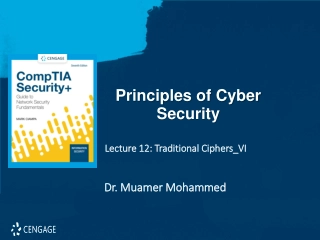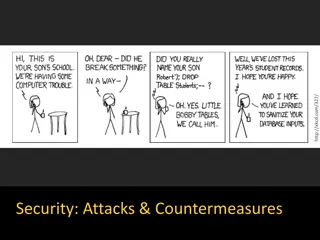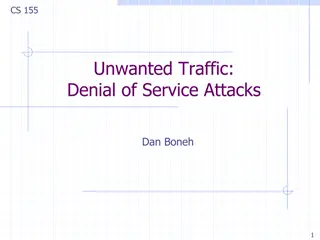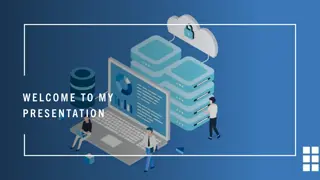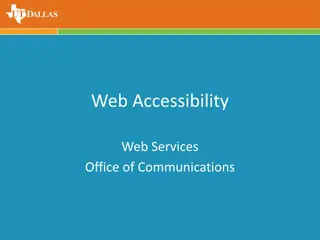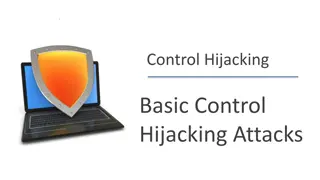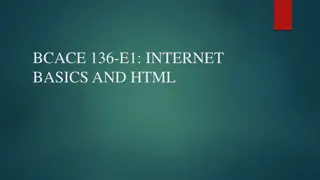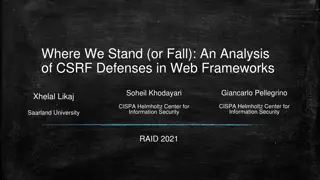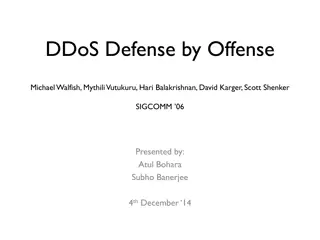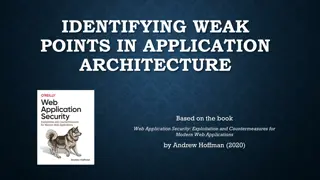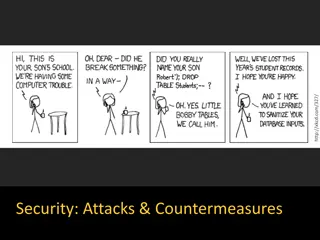Types Cyber Attacks: Cyber Security Training Workshop
Join our Cyber Security Training Workshop to learn about different types of cyber attacks such as social engineering attacks, DDoS attacks, malware attacks, MitM attacks, APTs, and password attacks. Enhance your knowledge and skills in cyber security.
15 views • 45 slides
Adversarial Machine Learning
Evasion attacks on black-box machine learning models, including query-based attacks, transfer-based attacks, and zero queries attacks. Explore various attack methods and their effectiveness against different defenses.
21 views • 60 slides
Understanding Malicious Attacks, Threats, and Vulnerabilities in IT Security
Malicious attacks, threats, and vulnerabilities in IT systems pose significant risks and damages. This chapter explores the types of attacks, tools used, security breaches, and measures to protect against cyber threats. Learn how security professionals safeguard organizations from malicious attacks
0 views • 24 slides
Principles of Cyber Security
Threat actors prioritize targeting networks to exploit vulnerabilities, leading to various attacks such as interception, DNS attacks, and MITM attacks. MITM attacks involve eavesdropping on communications or impersonating parties, with techniques like session replay to steal credentials. Implementin
0 views • 7 slides
Understanding Network Security Fundamentals and Common Web Application Attacks
Learn about the basics of network security, including common web application attacks such as Cross-Site Scripting (XSS), SQL Injection, and Session Hijacking. Explore important concepts like cookies, markup languages, and ways to enhance security to protect against cyber threats.
0 views • 11 slides
Web App Security: Common Attacks and Preventive Measures
Explore common web application attacks like eavesdropping, SQL injection, and packet sniffing, along with their countermeasures like encryption with SSL. Learn how to prevent data breaches and secure your online platforms effectively.
2 views • 29 slides
Managing Covid-19 Cyber and Data Protection Risks
Exploring the risks and challenges related to cyber attacks and data protection amidst the Covid-19 pandemic. The agenda covers an overview of cyber-attacks, recent developments, protections against cyber attacks, data protection concerns during lockdown, compliance steps, and employee rights issues
1 views • 35 slides
Mitigation of DMA-based Rowhammer Attacks on ARM
Practical strategies are presented in "GuardION: Practical Mitigation of DMA-based Rowhammer Attacks on ARM" to defend against Rowhammer attacks on ARM architecture. The paper discusses Rowhammer defenses, RAMPAGE attacks on Android OS, and introduces GuardION as a lightweight mitigation approach. I
0 views • 48 slides
Cybersecurity Challenges: Attacks on Web Applications and Cost of Security Breaches
In the realm of cybersecurity, attacks on web applications pose a significant threat with 78% of attacks targeting applications. The consequences of these attacks are immense, with projected costs reaching $6 trillion annually by 2021. Notable breaches in recent years highlight the urgency for robus
8 views • 23 slides
Understanding Denial-of-Service Attacks and Defense Strategies
Denial-of-Service attacks pose a serious threat where attackers flood networks with traffic, leading to system crashes and slowdowns. Explore the impact, expected results, and various categories of DoS attacks such as bandwidth attacks, protocol exceptions, and logic attacks. Learn how to defend aga
0 views • 61 slides
Understanding Network Denial of Service (DoS) Attacks
Network Denial of Service (DoS) attacks aim to disrupt services by overwhelming them with traffic. These attacks can occur at various layers of the network stack and exploit weaknesses to achieve their goal. Amplification attacks, such as the Smurf attack and DNS Amplification attack, can significan
2 views • 52 slides
Understanding Internet Basics and Web Browsers
This content covers the basics of the Internet and World Wide Web, including the differences between the two, the functions of web browsers, components of Internet Explorer, parts of the World Wide Web, conducting effective Internet searches, understanding search results, evaluating websites, and di
0 views • 49 slides
Understanding Web Hosting and Server Types
Web hosting is a service that enables individuals and organizations to make their websites accessible via the World Wide Web. It provides necessary infrastructure, storage, and connectivity to ensure websites are available to users 24/7. The web hosting process involves domain names, DNS translation
0 views • 9 slides
Understanding Web Accessibility and Its Importance
Web accessibility ensures that websites are designed to be inclusive and accessible to all users, regardless of their abilities. By removing barriers, web accessibility allows equal access to information and functionality, benefiting not only users but also businesses. Accessibility is vital in vari
0 views • 10 slides
Exploring the Fundamentals of Web Engineering
Delve into the world of web engineering with an introduction to its motivation, basic paradigms, conceptual architecture, history, protocol stack, the role of the World Wide Web Consortium (W3C), and the nature of web applications. Understand the categories of web applications and how they provide s
0 views • 51 slides
Preventing Active Timing Attacks in Low-Latency Anonymous Communication
This research addresses the vulnerabilities of onion routing to timing attacks and proposes solutions to prevent active timing attacks, focusing on low-latency anonymous communication systems. Various problems related to timing attacks in onion routing are analyzed, including the role of adversaries
0 views • 52 slides
Understanding Control Hijacking Attacks in Software Systems
Control hijacking attacks, such as buffer overflows and format string vulnerabilities, allow attackers to take over a target machine by manipulating application control flow. Knowledge of C functions, system calls, CPU, and OS used is crucial for executing these attacks successfully. This summary pr
1 views • 55 slides
Effective Method to Protect Web Servers Against Breach Attacks
Abdusamatov Somon presents an effective method called HTB to protect web servers against breach attacks, focusing on secure computation and mitigation. The research addresses side-channel attacks based on compression and the CRIME BREACH issue, providing insights into implementing the breach attack
1 views • 13 slides
Strategies to Protect School Systems from Cyber Attacks
Schools are increasingly becoming targets of cyber attacks, making cybersecurity measures crucial. The article discusses the importance of responding to cyber attacks, creating incident response plans, and being vigilant against interception attacks. It outlines the steps to detect, document, and mi
0 views • 21 slides
Understanding Sensor-Based Mobile Web Fingerprinting and Attacks
This content discusses sensor-based mobile web fingerprinting, cross-site input inference attacks, smartphone sensors, motion sensor data collection, and HTML5 DeviceMotionEvent interface. It highlights the potential security risks associated with sensor data access on mobile devices and the need fo
0 views • 30 slides
Understanding Web Browsers and Internet Explorer
Web browsers are essential software applications that allow users to navigate the internet by interpreting HTML files, handling multimedia content, managing history, and more. Learn about the features of web browsers, their support for web standards like HTML and JavaScript, and how to open Internet
0 views • 17 slides
Automated Signature Extraction for High Volume Attacks in Cybersecurity
This research delves into automated signature extraction for high-volume attacks in cybersecurity, specifically focusing on defending against Distributed Denial of Service (DDoS) attacks. The study discusses the challenges posed by sophisticated attackers using botnets and zero-day attacks, emphasiz
0 views • 37 slides
Understanding Silverlight for Web Hosting Companies
Silverlight is a versatile web technology that provides cross-browser and cross-platform capabilities for creating rich internet applications. It allows for XML-based graphics, animation, audio, video, and event handling, scripted with JavaScript. Integration with web servers via AJAX design pattern
0 views • 16 slides
Targeted Deanonymization via the Cache Side Channel: Attacks and Defenses
This presentation by Abdusamatov Somon explores targeted deanonymization through cache side-channel attacks, focusing on leaky resource attacks and cache-based side-channel attacks. It discusses the motivation behind these attacks, methods employed, potential defenses, and the evaluation of such att
0 views • 16 slides
Understanding Network Security Vulnerabilities and Attacks
Explore the world of network security vulnerabilities and attacks, including Denial-of-Service (DoS) and Distributed-Denial-of-Service (D-DoS), security flaws in the TCP/IP protocol suite, ICMP attacks, routing attacks, and TCP attacks. Learn about common security vulnerabilities such as address spo
0 views • 36 slides
Analysis of CSRF Defenses in Web Frameworks
This study delves into CSRF attacks, a long-standing web vulnerability, and evaluates the effectiveness of CSRF defenses in popular web frameworks. It addresses the lack of knowledge about the security of CSRF defense implementations and their susceptibility to misuse, aiming to enhance understandin
0 views • 37 slides
Understanding Web Security: Same-Origin Policy in Web Applications
In web development, the Same-Origin Policy plays a crucial role in ensuring the security of web applications by restricting how documents or scripts loaded from one origin can interact with resources from another origin. This policy helps prevent malicious attacks such as Cross-Origin Request Forger
0 views • 25 slides
Understanding Network Interference in CS590B/690B Lecture
Delve into the realm of network interference through the CS590B/690B lecture with Phillipa Gill at UMass Amherst. Explore topics such as Internet routing, timing attacks, BGP hijacks, Tor network functionality, relay selection, collusion scenarios, use of guards, web site fingerprinting attacks, tra
0 views • 11 slides
Basic Web Security Model for Secure Electronic Commerce
This presentation covers the basic web security model for secure electronic commerce, focusing on vulnerabilities such as XSS and SQL injection. It discusses the decline in web vulnerabilities since 2009 and explores reported web vulnerabilities. The course theme includes topics like web application
0 views • 38 slides
Understanding Web Security: Threats and Protections
Exploring the landscape of web security through discussions on historical vulnerabilities, top web threats, browser security models, and the goals of web security. Delve into the world of web programming, security threat models, and learn about the goals and importance of maintaining a secure web br
0 views • 74 slides
Comprehensive Guide on XSS Attacks and Defense Strategies
Explore the intricate details of Cross-Site Scripting attacks, the anatomy of XSS attacks, safe ways to represent dangerous characters in web pages, defense mechanisms based on data types and contexts, and the significance of encoding and output handling. Learn how attackers misuse XSS to hijack ses
0 views • 32 slides
Machine Learning for Cybersecurity Challenges: Addressing Adversarial Attacks and Interpretable Models
In the realm of cybersecurity, the perpetual battle between security analysts and adversaries intensifies with the increasing complexity of cyber attacks. Machine learning (ML) is increasingly utilized to combat these challenges, but vulnerable to adversarial attacks. Investigating defenses against
0 views • 41 slides
Ultimate Guide to Own Web Now's Web Hosting Platform
Dive into Own Web Now's web hosting platform through this comprehensive startup guide, which covers the process of ordering website hosting, deployment, management, and publishing website content. Learn about the Linux/PHP and Windows ASP.NET hosting options, how to configure your hosting account, m
0 views • 7 slides
Web Application Vulnerabilities: A Growing Concern
Web application vulnerabilities like code injection, SQL injection, cross-site scripting (XSS), and cross-site request forgery (CSRF) are becoming more common, posing serious threats to online security. Developers must tackle the complexity of filtering input and ensuring secure code to prevent mali
0 views • 23 slides
Understanding DDoS Attacks and Defense Strategies
In computing, DDoS attacks aim to disrupt machine or network services by overwhelming resources. This article delves into the concept of DDoS, application-level attacks, botnets, defense mechanisms like profiling and rate-limiting, and the effectiveness of the "Speak-Up" approach in mitigating DDoS
0 views • 26 slides
Exploring Privacy on the Web: Understanding the Deep and Dark Web
Delve into the intricate world of internet privacy, from the surface web to the hidden realms of the deep and dark web. Discover the importance of safeguarding personal data online, the significance of the Deep Web's unindexed content, and the intricacies of the Dark Web accessible via specific soft
0 views • 25 slides
Understanding Weak Points in Web Application Architecture
Information collected during the reconnaissance process can unveil critical aspects of a web application's architecture, including technologies used, API endpoints, functionality, domains, configurations, and authentication systems. Vulnerabilities in web applications often stem from poorly designed
4 views • 13 slides
Web Application Security: Uncovering Common Attacks and Countermeasures
Explore common web application attacks such as eavesdropping and injection, along with effective countermeasures like encryption through SSL. Learn how to prevent attacks and secure your web apps.
0 views • 29 slides
Understanding DDoS Attacks: Simulation, Analysis & Defense
Delve into the world of Distributed Denial of Service (DDoS) attacks with this comprehensive study covering the architecture, advantages, bot installation phases, attack methods, defenses, and simulation. Learn about the detrimental impact of DDoS attacks on servers, their multi-tiered structure, an
0 views • 20 slides
Overview of DoS and DDoS Attacks in Cybersecurity
This content provides an in-depth overview of Denial of Service (DoS) and Distributed Denial of Service (DDoS) attacks in cybersecurity. It covers the types of attacks, including volumetric, reflected, and stealthy, along with detailed explanations and examples. Additionally, it discusses how DoS at
0 views • 8 slides



